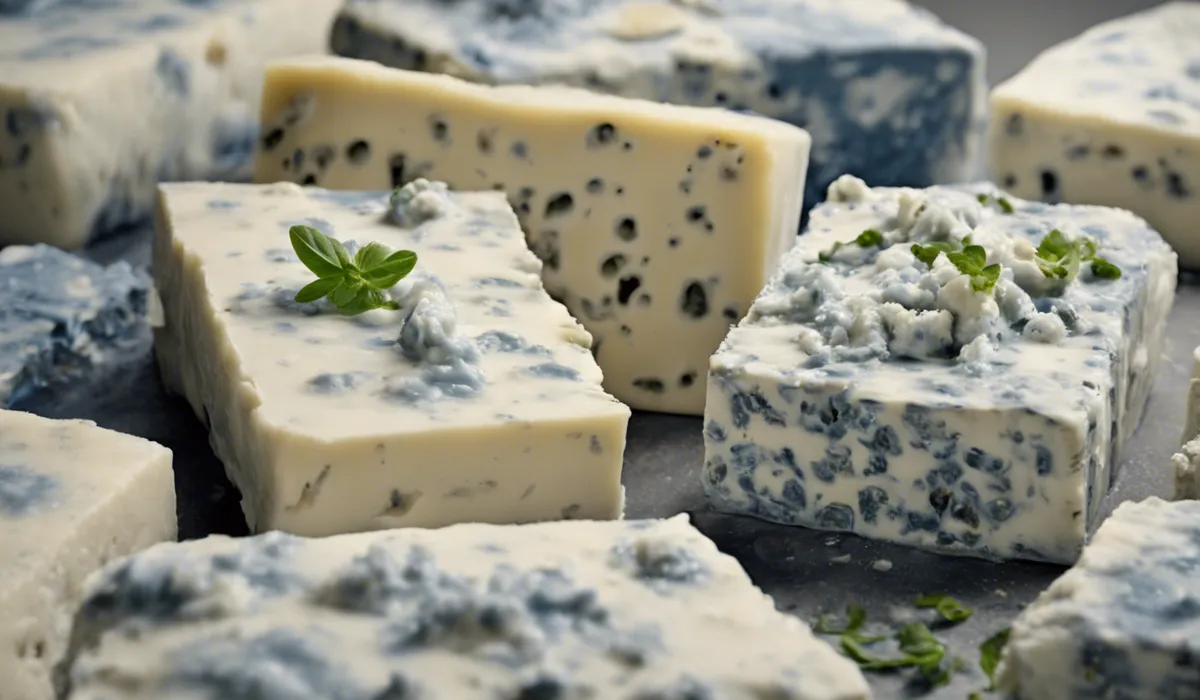Yes, Gorgonzola cheese contains mold. It’s an essential ingredient that contributes to its distinct flavor and veining. The mold Penicillium glaucum is added during production to create its characteristic texture and taste.
Nature of Gorgonzola Cheese

Description of Gorgonzola as a Blue Cheese
Gorgonzola is a renowned blue cheese originating from Italy, known for its creamy texture and distinct veins of blue mold that contribute to its sharp and salty flavor profile.
The cheese is made from unskimmed cow’s milk and earns its classification as a blue cheese from the blue or green moldy veining created by the mold strains introduced during its production.
This unique aspect sets it apart from other cheeses and is a defining characteristic that cheese aficionados cherish.
Role of Mold in the Cheesemaking Process
In the cheesemaking process, mold plays a crucial role in the development of flavor, aroma, and texture.
For Gorgonzola, the introduction of specific mold strains helps to break down the milk proteins and fats, allowing for the development of the cheese’s soft, spreadable texture and robust taste.
The mold’s enzymes are responsible for the cheese’s maturation, transforming it from a bland curd into a rich and complex cheese.
Types of Gorgonzola
Gorgonzola comes in two main varieties: Gorgonzola Dolce and Gorgonzola Piccante. Gorgonzola Dolce, known as the sweet variety, has a milder flavor and a creamy consistency.
It is generally aged for a shorter period of about two to three months. On the other hand, Gorgonzola Piccante, also referred to as the spicy type, is aged longer, usually for six months or more, resulting in a firmer texture and a more pronounced, sharp flavor that intensifies with age.
Mold Strains Used in Gorgonzola

Penicillium Glaucum Characteristics and Contribution
Penicillium glaucum is the main mold strain used in the production of Gorgonzola cheese. It is responsible for the characteristic blue veining and contributes significantly to the cheese’s flavor profile.
The mold imparts a unique earthiness and complexity that can range from mild to piquant, depending on the variety of Gorgonzola.
This mold’s ability to thrive in the low-oxygen environment inside the cheese is essential for creating the signature pockets and streaks that are typical of Gorgonzola.
How Mold is Introduced to the Cheese?
The introduction of Penicillium glaucum into Gorgonzola cheese is a deliberate and controlled process.
After the initial curdling of the milk, the mold spores are added to the mix. The cheese is then pierced with stainless steel rods to allow oxygen in, which enables the mold to grow and create the veins.
This process, known as needling, is critical to ensure that the mold spreads evenly throughout the cheese, contributing to its consistent flavor and texture.
Development of Mold Throughout Aging
As Gorgonzola ages, the mold continues to grow and develop. The aging process allows the flavors to deepen and the texture to become more pronounced.
The environment in which the cheese is aged, including the temperature, humidity, and duration, all play a role in the development of the mold and the resulting characteristics of the cheese.
Regular turning and monitoring of the cheese wheels are essential to ensure even mold distribution and the development of desirable flavors.
Health and Consumption of Mold in Gorgonzola

Safety of Consuming Mold in Cheese
The mold in cheeses like Gorgonzola is perfectly safe to eat and is actually an integral part of the cheese’s identity.
The strains used are edible and have been carefully selected for their safety and flavor-contributing properties.
Unlike the mold that grows on old bread or spoiled food, the mold in Gorgonzola is non-toxic and is not harmful to most people.
However, individuals with mold allergies or weakened immune systems should consult with a healthcare provider before consuming moldy cheeses.
Potential Health Benefits of Edible Mold
Edible molds, such as those found in Gorgonzola, can offer certain health benefits. These molds contain probiotics, which are live bacteria and yeasts that are good for your health, especially your digestive system.
They can help balance the gut flora and contribute to overall gut health. Additionally, cheeses like Gorgonzola are rich in nutrients such as protein, calcium, and vitamins, making them a beneficial addition to a balanced diet.
Guidelines for Consuming Moldy Cheeses and When to Avoid Them
When it comes to consuming moldy cheeses, there are a few guidelines to keep in mind. It is important to store cheese properly, keeping it wrapped in parchment or wax paper and refrigerated to maintain its quality and safety.
If you notice any unusual or off-putting smells, colors, or textures that differ from the cheese’s normal characteristics, it is best to discard it.
Pregnant women, young children, the elderly, and those with compromised immune systems should avoid consuming mold-ripened cheeses, including Gorgonzola, due to the potential risk of listeriosis.
FAQs About Gorgonzola and Mold
Is mold a normal part of Gorgonzola cheese?
Yes, mold is a natural and essential ingredient in Gorgonzola cheese, contributing to its flavor and appearance.
What type of mold is in Gorgonzola cheese?
Gorgonzola cheese contains the mold Penicillium glaucum, which is responsible for its texture and taste.
Can you eat the mold in Gorgonzola cheese?
Yes, the mold in Gorgonzola cheese is safe to eat and is integral to the cheese’s unique characteristics.
Does the mold in Gorgonzola cheese contribute to its veining?
Yes, the mold Penicillium glaucum creates the distinctive blue-green veins that run through Gorgonzola cheese.
Is the mold in Gorgonzola cheese the same as Penicillin?
No, while Penicillium glaucum is related to the genus Penicillium that includes the antibiotic penicillin, they are not the same, and the mold in Gorgonzola is used for its flavoring properties.
Final Thoughts
Gorgonzola cheese indeed has mold, with Penicillium glaucum being a crucial component.
This mold is intentionally added during the cheesemaking process, imparting the cheese with its unique flavor and marbled appearance. The mold’s presence is not only safe but essential for developing Gorgonzola’s signature qualities.
